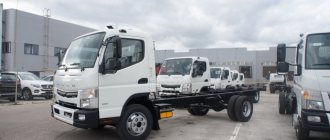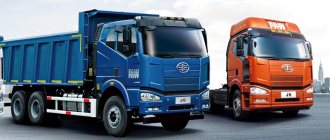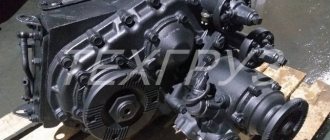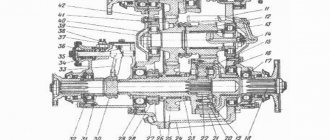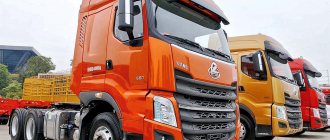Home / Trucks
Back
Published: 09.21.2018
Reading time: 6 min
0
52164
Rate this article
The relevance of freight transport is only increasing year by year. Various types of inventory items are delivered daily with their help over long and short distances. In accordance with international standardization, such cars are divided into several classes according to their carrying capacity. N1 means vehicles capable of carrying no more than 3.5 tons of any cargo. These are the ones that will be discussed further. Ideally, it is better to immediately take 5-ton trucks. But there are situations when 3.5-ton trucks are quite suitable. It all depends on personal goals.
An interesting video about the intricacies of working in cargo transportation, especially about choosing a vehicle for long-distance driving:
In addition to carrying capacity as such, there is a division into vehicles with an open or closed body. We most often find the first type in the form of dump trucks, flatbed trucks, timber carriers, etc. Closed bodies are equipped with tilt cars, isothermal vans (refrigerators), tanks, etc.
- Rating of the most famous trucks up to 3,500 kg
- Gazelle (GAZ 3302)
- Very popular Ford Transit
- Mercedes Benz Atego - a German-made truck
- MAN TGL - another car from Germany
- KAMAZ 4308 - the legendary Russian truck
- Popular Belarusian-made truck - MAZ 4371
- German compact truck Volkswagen Crafter
Main characteristics
Vehicles with a carrying capacity of up to 3 tons are quite spacious, reliable and designed for small volumes. Body length - no more than 5.5 m, height and width - up to 2.2 m, number of Euro pallets - up to 10. Due to the choice of several types of loading and various body modifications, such trucks are often ordered. Adamos Logistic has a large fleet of vehicles. That's why our clients don't wait weeks for their turn. The main advantage of trucks up to 3 tons is their compact size combined with the required carrying capacity.
Good maneuverability ensures ease of use in urban environments. Van-type vehicles with a carrying capacity of up to 3 tons are economical. They are often used to transport furniture when moving or delivering from a store. It will be useful to commercial clients and individuals.
A comfortable van is the best choice for small tonnage. It is useful when transporting food, building materials, office equipment, household appliances, alcoholic beverages, medical or industrial equipment.
Advantages of working with our company
If you are a person who values your time and reputation, if efficiency and timely delivery are your priorities, then cargo transportation with a hydrolift is exactly what you need. A car with a tail lift, which you can always order from our company, will save not only money, but also your own nerves and time. All loading and unloading work will be completed as quickly as possible, which will avoid unnecessary downtime and failure to fulfill contracts and obligations.
Tariffs for cars with a carrying capacity of up to 3 tons
Type and volume of cargo, mileage, timing - the main calculation parameters. The total price includes the cost of related services: loading and unloading, packaging, labeling, placement in temporary storage warehouses and others - depends on the individual characteristics of transportation.
Cars with insulated vans - refrigerated vans, as a rule, are more expensive. They are used in the field of transportation of special cargo. Food and medical products need to be kept at a certain temperature. Eurotents - tilted semi-trailers are more often used for transporting large loads. Transport specialists have many years of experience in the field of cargo transportation. We find solutions for inexpensive and efficient transportation of goods across the Russian Federation. An accurate calculation of cargo transportation can be made on the website’s calculator or by ordering a call.
KAMAZ 4308 - the legendary Russian truck
The cars of this manufacturer have been and remain one of the most popular in the cargo transportation market, primarily in terms of the ratio of performance quality and cost. In addition, they are considered to be quite unpretentious in terms of maintenance, and there are no difficulties with spare parts. They are equipped with 6-cylinder power plants with a power of 140 hp.
Capable of reaching speeds of up to 105 km/h. They have been produced for more than 10 years and are used quite often as on-board platforms on which special equipment can be installed, as well as for transporting various cargoes. The engine was specially developed for this model: when the truck is empty, it consumes 16-18 liters, and when fully loaded, it consumes up to 24 liters of fuel.
Our fleet
We carry out 90% of transportation using all major types of trucks
Thermos
Cargo transportation using isotherms maintaining constant temperature and humidity
Load capacity: 4 - 15 tons
Truck
Road transport by trucks over short and long distances
Load capacity: 1 - 5 tons
Refrigerator
International transportation of goods by refrigerated trucks maintaining the temperature within the range from +18°С to −18°С
Load capacity: 1.5 - 20 tons
MAN TGL - another car from Germany
Enjoys extremely positive reviews among Russian drivers. We should also highlight the convenient and comfortable cabin, even for long trips. The machine is equipped with a diesel power unit, which has 4 cylinders, turbocharging and its own cooling. It is one of the best for intracity and local cargo transportation.
Based on it, a large number of modifications are produced: isothermal van, dump truck, manipulator, tanker truck, concrete mixer, flatbed and tilt trucks. A tangible advantage of the model is its relatively low fuel consumption. But the car is very sensitive to its quality and on average a truck consumes about 20 liters per 100 km. As for the transmission, a 6-speed manual transmission is usually installed, and the engine capacity is about 4600 cm3.
It will also be interesting to read: 12-ton trucks - rating of the best offers on the market
We also provide the following services:
- Cargo transportation 3 tons
- Cargo transportation 5 tons
- Cargo transportation 6 tons
- Cargo transportation 7 tons
- Cargo transportation 10 tons
- Cargo transportation 20 tons
Vehicles with a carrying capacity of 3 tons are a transport category that is characterized by increased demand among customers of logistics companies. This circumstance is due to the increased maneuverability of light-duty transport - an indispensable property in conditions of busy traffic in large cities. , a 3-ton truck is marked N1. In logistics schemes, “low-tonnage trucks” are most often used to move goods within the city or for relatively nearby suburban transportation.
Load categories
There is no formal division of vehicles into categories based on carrying capacity, but conventionally they are usually divided into three large groups: small-, medium- and large-tonnage. Due to the fact that the division is conditional, the boundaries between groups can “float” and blur - for example, the carrying capacity of an average tonnage can vary from 2.5–5 to 2.5–8 tons. Sometimes especially large vehicles are allocated separately for transporting the heaviest and largest cargo - we will also talk about that. Load capacity refers only to the estimated weight of the load. Let's take a closer look at the classification of trucks by load capacity.
Light duty trucks
Light-duty transport refers to trucks capable of carrying up to 2.5 tons of cargo. Typically, such vehicles are used for local transportation (for example, within the region) and small cargo. Often, low-tonnage trucks are used to transport bread and other fresh products across the region. A separate category of light-duty vehicles is isothermal trucks. Thanks to the thermally insulated walls of the body, they are able to maintain the set temperature required for the product for some time. The initial temperature is not maintained for very long, so isothermal vans are used only for short-distance transportation.
Typical representatives of light-duty trucks are Gazelle, Hyundai Porter, Kia Bongo. Most light-duty trucks have a load capacity of up to 2 tons.
Light-duty vehicles differ from other trucks in their design - the driver's cab is located on the same frame with the cargo body. This design provides increased maneuverability and driving confidence. Light-duty trucks are capable of developing quite good speeds (compared to other trucks), while maintaining the ability to maneuver quickly and accurately. In addition, all city roads are open to them.
Most often, light-duty trucks are ordered by individuals and small companies (for example, individual entrepreneurs), but sometimes large businesses also need them - for example, to supply perishable products from a local warehouse.
Medium-duty transport
The carrying capacity of medium-duty vehicles is from 2.5 to 8 tons; sometimes the category is narrowed to 2.5–5 tons. This is perhaps the most popular category of trucks: both small and large businesses turn to them. The main advantage of medium-tonnage trucks is the ability to use almost all city roads and highways, because restrictions are usually set at 8 tons and above. Thus, a medium-tonnage truck is capable of transporting large cargo directly, without wasting time on detours along permitted highways. Medium-tonnage vehicles are rightfully considered the “golden mean” - they can transport very large loads, but at the same time they use fuel economically and have fairly good maneuverability.
Medium-duty vehicles include many KamAZ models, the popular GAZ-33106, and ISUZU trucks. As a rule, these are two-axle cars, and the cabin and body are located on a single frame.
The advantages of medium-duty vehicles are a comfortable cabin, an economical engine and low cost of vehicle repairs, which has a good effect on the rental price.
Heavy duty trucks
The large-tonnage category includes vehicles capable of transporting loads of 8 tons and above. Most often, trucks with a carrying capacity of 10–20 tons are included in this category. These vehicles can be part of road trains. They are not maneuverable, but they are perfectly suited for covering long distances: most large-tonnage trucks provide a comfortable sleeping area for the driver.
Large-capacity trucks are necessary equipment for large businesses that own warehouses and stores in different parts of the country (or even in different countries). It is large-capacity vehicles that usually transport goods over such long distances. Refrigerated semi-trailers equipped with a refrigeration unit are especially popular. They are designed for transporting deep-frozen products. Unlike isothermal vans, refrigerators are able to maintain the set temperature as long as required (as long as the refrigeration unit is running), and therefore allow food to be transported over very long distances.
The design of heavy-duty trucks, as a rule, is not integral - the cab and body are located on separate frames. Thanks to this feature, “large-tonnage trucks” can transport a semi-trailer on a movable axle connection. The truck itself is usually equipped with three axles.
An example of a large-tonnage truck is the Scania P 280 6×2HNB - a three-axle truck with a payload capacity of 10 tons.
Extra large trucks
Sometimes a fourth is added to the three categories of carrying capacity—vehicles with particularly large carrying capacity. This includes vehicles capable of transporting 16 tons and above (in some classifications - from 20 tons). Three-axle, four-axle trucks and road trains can be especially large. As a rule, this category is represented by collapsible structures like the Renault Premium - a truck tractor that can transport up to 11.4 tons without a hitch, and when coupled with a tilt semi-trailer it can handle 25 tons of cargo.
Particularly large vehicles are used by big businesses for intercity and international transport. Unlike light-duty trucks, such vehicles are usually not found within the city - they ply along highways between regional warehouses.
Practical advantages of “three-tonners” relative to their larger counterparts
A truck weighing 3 tons is distinguished by its spaciousness. This allows it to be actively used in the delivery of even bulky goods over relatively short distances, especially if the client is committed to meeting deadlines and the speed of transportation is a priority.
Light duty truck:
- Does not create difficulties when parking even in cramped spatial conditions;
- Technically reliable, because it is distinguished by the simplicity of design solutions (depending on the specific model);
- Characterized by a comfortable loading height;
- Has a slight reversal degree.
Mercedes Sprinter with a tail lift of 18 - 20 m3, transports 8 euro pallets.
|
For which objects is the transportation of 3 tons of cargo relevant?
There are no unambiguous restrictions on transportation by 3-ton vehicles, but practice shows that it is most convenient to transport medium-sized objects from the product category with this type of transport.
Cargo transportation of 3 tons is most often:
- Trade equipment for stores;
- Furniture items for office or home use;
- Industrial group goods;
- Rolled metal products;
- Household items when moving;
- Construction materials;
- Product range with limited expiration dates;
- Pharmaceutical preparations.
Mercedes Benz Atego - a German-made truck
One of the best options for its functionality. The truck is equipped with a diesel engine with a power of 177 horsepower. This model is supported by its exceptional operational reliability, easy controllability and maneuverability, as well as relatively low fuel consumption. Thanks to the introduction of special developments, the emission standards for toxic substances have been reduced.
The design of the cabin has not changed since previous generations of the machine, but the latest modification has added handrails and a technological step. Thanks to the aerodynamic fairing, the car became easily recognizable. Today the model range is represented by a four-wheel drive truck, a flatbed and a flatbed with 3-way loading and unloading.
Vehicles used
Transportation using a hydraulic lift (tail lift) involves the use of specialized vehicles that have special equipment and are in good condition. A car with a hydraulic lift (tail lift) must be quite spacious; the volume of transport we provide ranges from 16 to 46 cubic meters. Simply put, such a machine with a hydraulic lift is capable of transporting from 6 to 22 euro pallets. The costs of expensive human labor are significantly reduced, and it becomes possible to save not only money, but also the precious time of our clients, which we greatly value. Hydrolift cargo transportation is carried out in Moscow and the Moscow region, we will always deliver the goods faster and in complete safety.
Mercedes Actors - 7 tons with a tail lift of 46 m3, transports 17 euro pallets
|
Mercedes Atego / MAN - 5 tons with a tail lift of 36 m3, transports 15 euro pallets
|


